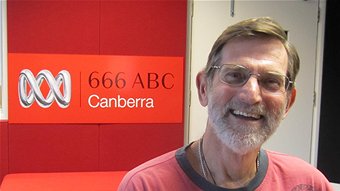Cockies wreck apple crops
 Monday, April 16, 2012 at 20:18
Monday, April 16, 2012 at 20:18
 Monday, April 16, 2012 at 20:18
Monday, April 16, 2012 at 20:18  Wednesday, April 11, 2012 at 23:08
Wednesday, April 11, 2012 at 23:08  Wednesday, April 4, 2012 at 1:44
Wednesday, April 4, 2012 at 1:44  Carnaby's Black Cockatoo researcher Denis Saunders. Image: Gabrielle Rumble - ABC
Carnaby's Black Cockatoo researcher Denis Saunders. Image: Gabrielle Rumble - ABC
Dr Denis Saunders bounces into the studio at 666, having walked up Mt Painter this morning, on a breathtaking Canberra autumn day. Sometimes he and his golden retriever ("the leggy blonde") have done about 11 or 12 km before breakfast.
The fit as a fiddle scientist has dedicated his life to preserving Western Australia's Carnaby's Black Cockatoo.
Denis came to Canberra with his parents in 1960. His love of nature was ignited at the family's beach house at North Rosedale on the South Coast, precious hours spent exploring on his own.
 Thursday, March 29, 2012 at 12:36
Thursday, March 29, 2012 at 12:36  Trees are vital to the Carnaby's cockatoo survival. Plant one today! Image by Delia AnthonyPlant's for Carnaby's is a list devised by the Department of Environment and Conservation detailing species that the endangered Carnaby black cockatoos use as feeding, roosting and nesting resources. It includes native and exotic species.
Trees are vital to the Carnaby's cockatoo survival. Plant one today! Image by Delia AnthonyPlant's for Carnaby's is a list devised by the Department of Environment and Conservation detailing species that the endangered Carnaby black cockatoos use as feeding, roosting and nesting resources. It includes native and exotic species.
The medium and high priority plants below, all native species, are fairly easy to get from nurseries around winter and onwards. Specialist native nurseries will have some of the more difficult to obtain species.
High priority food plants inlcude Banksia grandis, B. littoralis, B. prionotes, B. speciosa, B. prostrata and B. undulata. None of these plants are particularly tall or huge trees, though if you do have room to plant some large Eucalypts there are Tuarts (Eucalyptus gomphocephala), which grow in a 20 odd km strip along the coast between Jurien Bay to near Busselton (Powell, 1990). Marri (Corymbia calophylla) is an extremely important food species and after about 120 years of age they form hollows in which cockatoos can breed.
 Wednesday, March 21, 2012 at 23:55
Wednesday, March 21, 2012 at 23:55